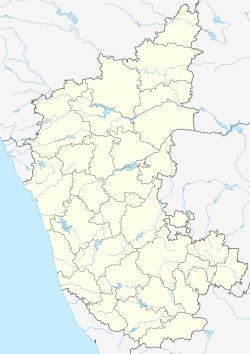
Venkateswara is a form of the Hindu god Vishnu and is the presiding deity of the Venkateswara Temple, located in Tirupati, Andhra Pradesh, India. Venkateswara is also known by various other names.

Haveri is a district in the state of Karnataka, India. As of 2011, it had a population of 1,597,668, out of which 20.78% were urban residents. The district headquarters is Haveri.
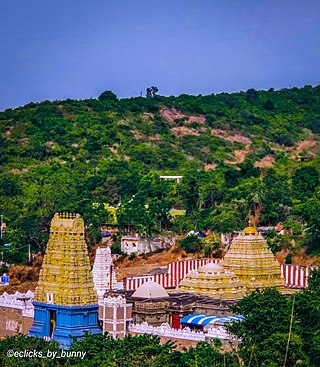
Sri Varaha Lakshmi Narasimha temple, Simhachalam, is a Hindu temple situated on the Simhachalam Hill Range,which is 300 metres above the sea level in Visakhapatnam, Andhra Pradesh, India. It is dedicated to Lord Vishnu, who is worshipped there as Varaha Narasimha. As per the temple's legend, Vishnu manifested in this form after saving his devotee Prahlada from a murder attempt by the latter's father Hiranyakashipu.Except on Akshaya Trutiya, the idol of Varaha Narasimha is covered with sandalwood paste throughout the year, which makes it resemble a linga. The temple was built in Kalingan architecture styles and stands unique in the historical region of Kalinga.The Present temple was built by Eastern Ganga king Narasingha Deva I in the 13th century and consecrated by his son Bhanudeva I in 1268 AD. The temple was built by Akthayi Senapathi, on the command of Narasingha Deva I.
Kuruba is a Hindu caste native to the Indian state of Karnataka, Tamil Nadu, Andhra Pradesh and Telangana. They are the third-largest caste group in Karnataka. The Kuruba community is also known by the names Kuruba. The natives of the Indian states of Karnataka, Tamil Nadu, Andhra Pradesh and Telangana are Hindu castes. It is the third largest caste group in Karnataka. Traditionally, these are shepherds who used to do the work of sheep/goat and animal husbandry, in which they especially raised mixed herds of sheep and goats and cattle.
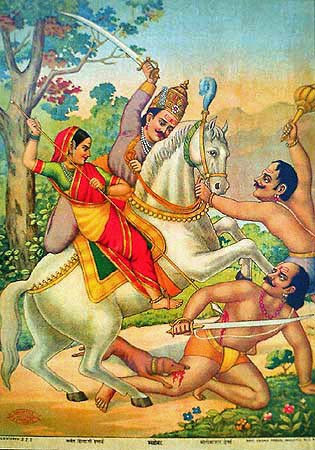
Khandoba, also known as Martanda Bhairava,, Malhari and Malhar, is a Hindu deity worshiped as a manifestation of Shiva mainly in the Deccan plateau of India, especially in the state of Maharashtra and North Karnataka. He is the most popular Kuladevata in Maharashtra. He is also the patron deity of some warrior, farming castes, shepherd community and Brahmin (priestly) castes as well as several of the hunter/gatherer tribes that are native to the hills and forests of this region. The sect of Khandoba has linkages with Hindu and Jain traditions, and also assimilates all communities irrespective of caste, including Muslims. The character of Khandoba developed during the 9th and 10th centuries from a folk deity into a composite god possessing the attributes of Shiva, Bhairava, Surya and Kartikeya (Skanda). He is depicted either in the form of a linga, or as an image of a warrior riding on a bull or a horse. The foremost centre of Khandoba worship is the temple of Jejuri in Maharashtra. The legends of Khandoba, found in the text Malhari Mahatmya and also narrated in folk songs, revolve around his victory over demons Mani-malla and his marriages.
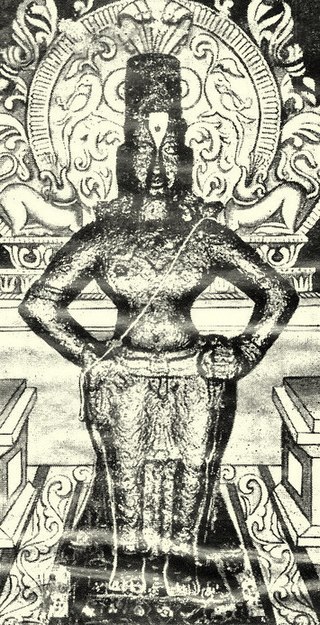
Vithoba, also known as Vitthala, and Panduranga, is a Hindu god predominantly worshipped in the Indian state of Maharashtra and Karnataka. He is a form of the god Vishnu. Vithoba is often depicted as a dark young boy, standing arms akimbo on a brick, sometimes accompanied by his consort Rakhumai.
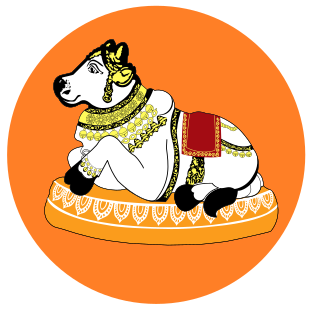
The Jangam or Jangamaru are a Shaiva order of religious monks. They are the priests (Gurus) of the Hindu Shaiva sect, Gurus of Veerashaiva sect and are disciples of Lord Shiva as mentioned in Basava Puranas. The meaning of word Jangam is 'moving linga'. Jangama is one who is endowed with true spirit of Agamic knowledge, and has sacrificed his life for giving Samskara (good) character building practices in all sections of the Hindu society.

Saptashrungi or Saptashringi is a site of Hindu pilgrimage situated 60 kilometres (37 mi) from Nashik in Indian state of Maharashtra. According to Hindu traditions, the goddess Saptashrungi Nivasini dwells within the seven mountain peaks. It is located in Nanduri, Kalwan taluka, a small village near Nashik in India. The Marathas and some Hindu tribes worship the goddess from a long time and some worship as their kuldaivat. There are 510 steps to climb the gad. Devotees visit this place in large numbers every day. The temple is also known popularly as one of the "three and half Shakti Peethas" of Maharashtra. The temple is also one among the 51 Shakti Peethas located on the Indian subcontinent and is a location where one of Sati's limbs, her right arm is reported to have fallen. Its half shaktipeeth among three and half shaktipeeth of Maharashtra.
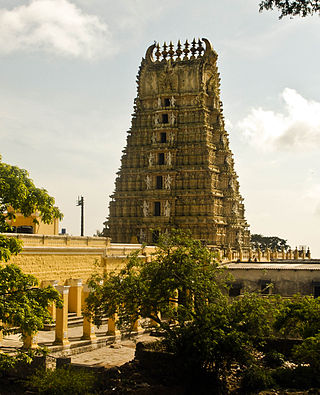
The Chamundeshwari Temple is a Hindu temple located on the top of Chamundi Hills about 13 km from the palace city of Mysuru in the state of Karnataka in India. The temple was named after Chamundeshwari or, the fierce form of Shakti, a tutelary deity held in reverence for centuries by the Maharaja of Mysuru.

Banashankari Devi Temple is a Hindu shrine located at Cholachagudda near Badami, in Bagalkot district, Karnataka, India. The temple is popularly called 'Shakambhari' 'Banashankari or Vanashankari' since it is located in the Tilakaaranya forest. The temple deity is also called the Shakambhari, an incarnation of the goddess Parvati.

Karnataka has a variety of traditional arts, including folk dance and puppetry.
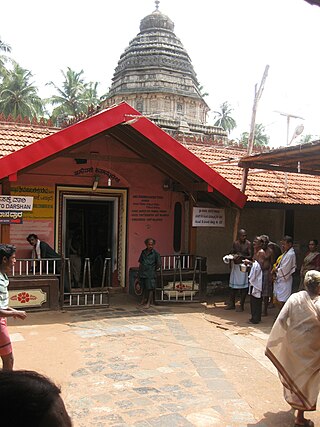
The Mahabaleshwar Temple, Gokarna is a 4th-century CE Hindu temple located in Gokarna, Uttara Kannada district, Karnataka state, India which is built in the classical Dravidian architectural style. It is a site of religious pilgrimage. The temple faces the Gokarna beach on the Arabian Sea. The temple deifies the Pranalinga also called Atmalinga or Shiva Linga In legend, it is said that the deity of the temple will bestow immense blessings to devotees, even to those who only glimpse it. Currently the administrative charge of the temple is with an Overseeing Committee under the Chairmanship of Justice BN Srikrishna, a Retired Justice of the Hon'ble Supreme Court of India. It is one of the 275 paadal petra sthalams expounded in the Tevaram, a sacred Tamil Shaivite text written during the 6th and 7th centuries by 63 saints called Nayanars.
Shri Kuruvathi Basaveshwara temple at Kuruvathi is one of the ancient and historic temples at the extreme south-western corner of Hoovina Hadagali taluk, Vijayanagara District, Karnataka, India. This temple is on the bank of Tungabhadra river, 10 km from Halavagalu and 2 km from Mylara and 36 km from Ranebennur and 326 km from Bangalore.
The Mylar Jaatre' is the biggest fair in Karnataka and one of the biggest in South India. More than 10 lakh devotees from all parts of the State and some neighbouring States congregate at Mylara, a pilgrim centre in Hadagali taluk, Bellary district, for the annual “Karnikotsava” (prophecy). The fair is celebrated every year at the local temple dedicated to Shiva in his form as Mailareshwara, the patron deity of the Kuruba Gowda community. Mylara is situated in the south-western corner of Hadagali taluk of the district, and is situated two km from Tungabhadra river and about 40 km from Hadagali town. It is believed that every year at Bharat hunnime, Elukoti with his wife Gangamalavva riding on a white horse will visit this place. People still experience thunder and lightning upon arrival of the God. This God believed to be a very fond of his bhaktas and will be pleased with Naivedya made of banana, sugar, ghee and milk mixed together.
Karnikotsava or prophecy is an ancient tradition followed by the Kuruba Gowda community of Karnataka. It is organised every year during the Mailara Jaatre in Bellary district of Karnataka. It is usually conducted in the month of February. The designated "Gorava," standing on top of a ten foot bow, prophesies what to expect in the coming year and lets himself down from that height to be caught by the devotees below. The Gorava, a follower of Mylara Lingeshwara, wearing a traditional overcoat of wool and headgear, traditionally fasts for the 11 days of the fair before prophesying on the penultimate day.
The term gorava refers to men and women belonging to the Kuruba community who have taken a special vow and dress in the traditional overcoat and headgear, and beat a damroo shouting "Elukoti.. Elukoti. Elukoti.", meaning seven crores - the number of Goravas Mailara, armed with a bow and arrows, took to battle against a demon, Mallasura and his brother. They also dance in ritualistic warrior-like dance called the Goravara Kunitha, which involves use of a small dollu in one hand and a flute in other. Goravas wear a headgear made of bear hair.

Gajasurasamhara, also Gajasamhara, Gajantaka and Gajaha and Matangari, is a fierce aspect of the Hindu god Shiva as the Destroyer of the elephant demon, Gajasura. The icon is popular in Pallava and Chola art, which portray him dancing vigorously in the flayed elephant hide of Gajasura.

Pasupatheeswarar Temple, Avoor or Avoor Pasupatheeswaram is a Hindu temple dedicated to Hindu god Shiva, located in the village Avoor, located 12 km south of South Indian town, Kumbakonam, Tamil Nadu, India. The temple is one of the 70 madakoil built by 2nd century Chola king, Kochengat Chola. The temple is known for the Panchabairavar, the five images of Bhairavar. The temple is revered in the verses of Tevaram, the 7th century Tamil Saiva canon by Tirugnana Sambandar.

The MajorVellayani Devi Temple is a highly revered shrine in Kerala, India, dedicated to goddess Bhadrakali. The shrine is situated in Vellayani 1.5 km west of Vellayani junction, 12 km southeast of Thiruvananthapuram on the eastern bank of Vellayani Lake. The temple is under the management of Travancore Devaswom Board. The temple structure has a bronze roof with traditional art work and carries Dravidian architecture. The temple has eastern and northern towers called Gopurams with statues of different Gods sculptured in them. The Gopurams function as gateways through the walls that surround the temple complex.

Veerateeswarar Temple is a Hindu temple located at Vazhuvur in Mayiladuthurai district of Tamil Nadu, India. The presiding deity is Shiva in the form of Veerateswarar and his consort is known as Bala Gujambigai. The village is mentioned in the 7th century Tamil Saiva canonical work, the Tevaram, written by Tamil saint poets known as the nayanars and classified as Vaippu Sthalam, the 276 temples that find mention in it.


